Foul Deeds
Antifoul has always been a hot topic aboard Mollymawk. We have always been troubled by the knowledge that conventional antifouling paints are expensive, highly toxic and, to a large extent, ineffective. Eight years have passed since we last slipped the boat and slapped on a coat of something nasty. In the intervening years we have kept a listening watch, hoping to hear of some new discovery which will solve our worries. Surely, there must be something which is bad for barnacles but not so bad that the sea becomes a poisonous soup? Surely there must be something that they just can’t stick to?
We are also concerned about the fact that we yotties have been made the scapegoat in the anti-antifoul, greener seas campaign. One of the favourite antifoul ingredients in the bad old days was tributyl-tin (TBT). This, we were eventually told, was extremely damaging to the environment, and in the 1987 it was banned – from yachting paints. But the big boats carried on using it right up until 1st January 2008! There are quite a lot of yachts in the world these days, but if you lined them all up their total area would still be completely insignificant compared to that of the world’s merchant and naval fleets.
There were those of us who had our doubts as to the accuracy of the research implicating TBT as a killer. Certainly, the chaps who got the stuff banned had never been anywhere near our boats; the sealife flourishing on the underside of our boats was so prolific and so healthy that the paint was nicknamed Fertiliser. But if TBT really is deadly, why were hundreds of thousands of tankers, and container ships, and ferries, and LPG carriers still wearing it for more than 20 years after the fact became known?
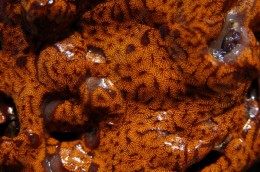
Unlike Big Business we yachtsmen, as a breed, are generally pretty keen on sealife. Big Business lives in an office block and a suburban mansionette and probably doesn’t give sealife much thought, but we live and travel out here, on the big blue marble. We are acutely aware of the fact that the ocean would be far less interesting if it were devoid of dolphins and turtles and tuna, and we recognise that these “end consumers”, at the top of the food chain, depend for their survival on the lower beings – including the embryonic barnacle, hunting for a home, and the globular sea squirt, and the oyster. We love them all – provided that they don’t try hitching a ride on our boats.
As a matter of fact, we Mollymawks are rather more tolerant than most yachtsmen of the beings which set up camp on the underside of our home. The various eccentric forms of life are objects of interest – particularly to the ship’s naturalist – and we often spend a happy half-hour exploring the garden with mask and snorkel. Actually, despite its appearance, most of the stuff which gets a grip on our boat is animal rather than vegetable – so perhaps I ought really to call it the zoo rather than the garden.
In any event, so long as we are in harbour, we Mollymawks tend to live and let live. When we want to move on we go over the side – either in the dinghy, or in our swimming trunks or our wetsuits – and we set to work, as a team, with a bunch of scrapers. Some of us feel quite bad about evicting the orange mess which our research has shown to be a distant cousin of man – a weird, but rather attractive, jelly-like colony which scientists classify as a vertebrate – and some of us even feel sad to say goodbye to the oysters and mussels. Nobody feels any pity at all for the razor-edged barnacles or the green slime… Anyway, we scrape it all off – and within a week it is all growing back again.
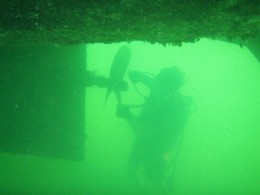
There is a positive side to this state of affairs: a boat with a foul bottom is always very popular with the fishes, and so we travel along with a well-stocked larder. But we travel slowly. The fact is that a boat which is covered in barnacles and weed just doesn’t go. Eventually, the propeller won’t turn and the rudder won’t move, and then the only recourse is to go over the side again. Thus, as I say, for the past eight years and more we have been waiting for the world to invent that perfect antifouling paint – one which is both effective and environmentally friendly.
Could there be such a thing, or are the two ideas diametrically opposed?
After they were banned from using TBT antifouling manufacturers turned to other metals, and notably to copper. Copper has for long been used as a deterrent to all sorts of marine life, including the dreaded toredo. The phrase “a copper-bottomed investment” is no longer much used, but most people have heard it. It is derived from the old practice of cladding the entire underside of a boat in a patchwork of copper sheeting. That the process came to be associated with a wise investment is demonstration of the fact that it worked; a copper-bottomed boat was likely to be sound. It was therefore only a matter of time before somebody came up with a means of applying a coat of pure copper to modern boats, made of fibreglass and steel. The means was a layer of epoxy heavily impregnated with copper powder, but the man who first came up with a marketable product was not a paint manufacturer, he was simply a yotty with a very good idea. He called his product Copperbot.
We were probably amongst the first yotties to try Copperbot. Certainly, at that time we knew of no one else who had tried it, and as the product was roughly twice the price of the most expensive antifoul it took all our courage and a substantial slice of our savings to give it a go. Within six months of applying the paint we knew that we had made a “copper-bottomed investment”. In a harbour notorious for fouling, where boats sometimes had to be slipped and cleaned after only a month long stay, ours was the only clean hull. A year later, when we slipped the boat (and sold her) there was not one barnacle on the entire hull. The only fouling was a thin layer of slime which washed off very easily.
When we built Mollymawk we naturally wanted to use the same scheme, but two things prevented us. One was the expense. The other was the fact that Copperbot was not available in South Africa. However, in the course of hunting for a solution we discovered that the manufacturer of this paint was actually importing the copper dust from South Africa… and so we decided to brew our own antifoul. By this time the original Mr Copperbot had died and the company had been taken over and renamed Coppercoat. Since they were unable to fulfil our needs Coppercoat very kindly told us exactly what type of epoxy we needed to use and how much copper powder was required, and we went ahead. The result was a cheap antifoul which looked just like the real thing.
Unfortunately, it didn’t work.
Copper works, as an antifoul, only if it is abraded. If the copper dust is completely encapsulated in epoxy the barnacles and their brethren just hop aboard in the usual way. Naturally, we did our best to abrade Mollymawk’s copper coat in the same way that we had abraded the copper bottom of our previous boat, but whereas the old boat’s fibreglass hull had been smooth and fair, Molly’s steel hull had already received four coats of thick, gooey epoxy. Its surface was textured like an orange, and since it was impossible to effectively abrade the miniature pits the sealife easily got a hold.
But is copper actually any better for the environment than tin, anyway? We have put this question to various people, including a fairly eminent member of Greenpeace, and the general consensus seems to be that copper is about a hundred times better than tin, but that it is still bad.
“What do you use aboard Rainbow Warrior?” we asked the woman at Greenpeace, after she had bad-mouthed yachting paints (and yachting in general).
She wouldn’t say. And nor would she let us quote her.
Clearly, this is a major problem then. If even the goodest good guys can’t own up and tell us what they are using for antifoul, we can assume that no wonderful new discoveries have yet been made.
But there is at least one entirely safe, entirely green, wholly organic product which has been proposed as an antifouling agent, and certain yachtsmen are saying that it is hot stuff. Indeed, it certainly is hot stuff. It’s chilli powder.
It was some months ago that we first came across the idea of mixing chilli powder into our paint, and since the Spanish don’t understand about hot food it has taken us quite a time to find a source. In fact, we ended up having to get some sent from the land of chicken vindaloo (ie England). Our research on the subject of spicy antifoul has led us to a couple of people who know someone who once met somebody whose friend knew a man who tried it – and so we have not been able to find any information about how much chilli to mix with the paint, nor even what kind of paint to use. Clearly, before we waste time any money spreading it all over the hull we need to run a trial – and this is it.
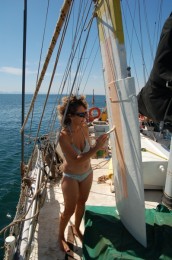
“What we need,” we said, “is a big piece of wood which we can paint with various different mixes and leave trailing behind the boat in the water.”
But we were not very keen on the idea of towing a piece of wood behind the boat – until we realised that we already had one there.
Yes, of course: the self steering rudder.
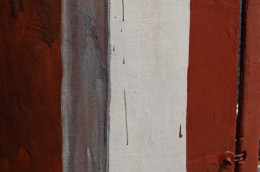
The self-steering rudder has now been decorated with five stripes of paint on each side. Starting at the trailing edge we have Hempels Vindaloo – a hot and spicy mix of the cheapest antifoul that we could find, with three heaped teaspoons of the hot stuff added. Immediately for’ard of this is the control stripe, consisting of unadulterated Hempels, and then, in the centre of the rudder we have a tasty looking, salmon-pink stripe consisting of white gloss paint generously spiced and coloured with ten heaped teaspoonfuls of the Main Ingredient. This mixture really does look good enough to eat – although we hope very much that the barnacles and oysters don’t agree. Directly for’ard of the yummy stripe we have our old friend, epoxy resin impregnated with pure copper, and finally, on the leading edge we have the same, home-brewed copper paint given extra strength and colour, and a great deal more viscosity, by the introduction of four teaspoons of chilli.
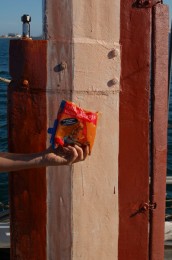
It was interesting to see how the different paints behaved when the powder was added. The antifoul was already quite thick and quickly became stodgy. The epoxy had been quite runny but soon became stiff. The ordinary household paint was only slightly more runny than the epoxy had been at the outset, and yet it swallowed down ten teaspoonfuls of chilli powder without there being any noticeable change in its consistency. I could easily have given it more.
Whereas the antifouling and the epoxy dried in the usual length of time, the gloss paint took more than 24 hours to harden, and during this time it lost its colour, the chilli powder seeming to sink to the back (although the back was not the lower surface).
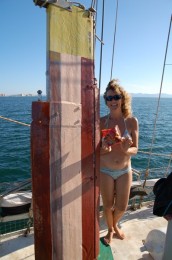
Now all that we have to do is put it in the water, and wait and watch. If we had been running this experiment a month or two ago we need only have waited a week, because at that time a week was all it took for Mollymawk’s freshly scraped hull to become re-infected with a liberal sprinkling of barnacles, etcetera. Now that the water is a few degrees colder things have slowed down – but still we reckon that within a month we will know whether barnacles, weed, and sea squirts love or abhor hot chilli pepper.
Watch this space!
If anybody out there has already tried this trick, do please let us know. Likewise, if you have any new ideas, or know of any effective but environmentally friendly antifouling, please tell the world here.
For an update on the various antifoulings applied to our self-steering rudder, see our review of Coppercoat.
For our latest research and observations on the subject, see The Search for an Effective and Environmentally-Safe Antifouling.

Hello
I recently came across your article form 2008 !! regarding chili powder in antifoul paint. I am about to embark on a similar excersise on my fleet of motor yachts in the Virgin Islands. Any advice you can offer with regards to your success, ratio of mixing etc, woudl be greatly appreciated.
many thanks
regards
Will Driver
Virgin Traders
Hullo Will,
We’re just about to post the results of our little test, in which we compared chilli powder, a conventional anti-fouling, and Coppercoat. Before we do so we would like to give Coppercoat the opportunity of commenting.
In the meantime, all I can say about the chilli powder is that it didn’t have much effect. We mixed in as much as the paint could bear, and it appeared to have no effect whatsoever, neither improving nor hindering the anti-fouling properties of the base paint.
Maybe you’ll have better luck – and if you do, be sure to let us know!
Jill